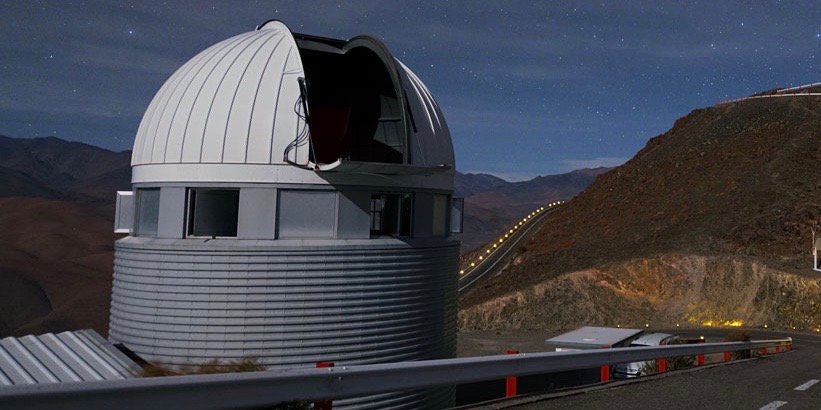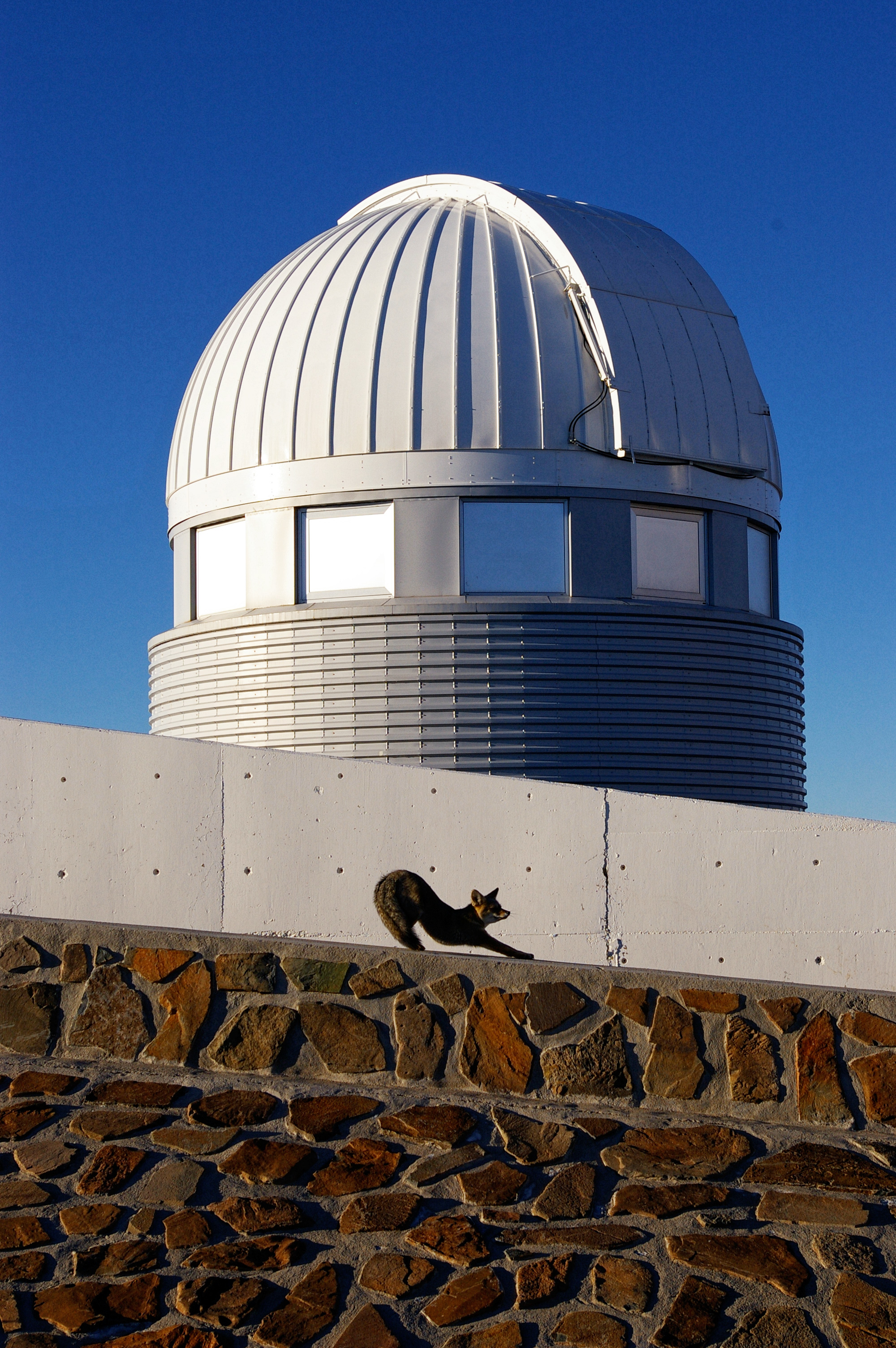A taste of the Andes from Geneva


In front of the dome housing the Swiss 1.2-metre Euler Telescope in La Silla, after a sunny day, a South American grey fox has just awoken – the representative of a nocturnal species that will remain in Chile. (Photo ESO/M. Tewes)
Following the discovery of the first exoplanet in 1995, the Department of Astronomy of the University of Geneva built and installed the Euler telescope at ESO’s La Silla Observatory in 1998. This 1.2m diameter telescope is connected to the high-resolution spectrograph CORALIE, whose software instantly computes precise radial velocities of observed stars in order to detect the possible presence of exoplanets orbiting the star. Euler and CORALIE together have produced 20 years of successful observations, many important results in the research domain of exoplanets. During this same period, this facility has been continuously improved. It allows us today to achieve a precision on radial velocities of a few meters per second and to contribute significantly in the search and characterization of extra-solar planets.
In order to operate Euler seven days a week and 365 days a year, the Geneva Observatory sends an astronomer to Chile every two weeks, i.e. approximately 20 to 25 people a year only to ensure observations. These costs do not include neither on-site support and corrective maintenance, nor technical missions. The new SNSF guidelines on maintenance and mission costs called furthermore for new funding models and a reconsideration of allocation of human and capital resources. With the aim of continuing successful operations of Euler also during the next decade, costs had therefore to be optimised and the operational model reviewed. Therefore, a new project was launched in 2017 to investigate the possibility of implementing remote observations.
During the past two years, researchers, engineers and computer scientists have focused on security issues to make the facility as safe as possible even in the absence of personnel. For instance, in case of a power failure in Geneva or La Silla, or a cut of the Internet connection, it is mandatory to secure the telescope and close the dome. “To test the Internet connection we had to set up a new system” explains Luc Weber who is responsible for the Operations and the Control System of the Euler Telescope and its instruments: “It’s a bit like the dead man’s technique used in trains: we test continuously whether the line is active, and if, after a while, we don’t get any answer from La Silla, we automatically close the dome”. The case of power cuts is a little different, as soon as the emergency batteries (UPS) are switched on during a main power failure, the dome is closed automatically.
Another example is the handling of changing weather conditions. Fortunately, Euler has its own weather station that transmits data also to the remote observer. Automatic threshold detection triggers actions like closing the dome and the windows, e.g. in case of strong winds, high humidity, etc. It might happen however that the weather station itself is offline or out of order. Who must decide whether or not to close the dome in such a case? At what conditions? Must the action be triggered by the system or by the observer? “It’s not obvious”, explains Luc Weber, “what to do if the weather monitor breaks down for 3 days when the outside conditions are good. There is still the possibility of using the information from ESO’s weather station, which however is not always reliable. One day it was so cold and humid that a block of ice formed around the humidity sensor”, recalls Luc Weber, “and it took several days for this ice to melt, during which the sensor indicated that the humidity was too high to observe.” Indeed, in this case the observer could have taken the decision to observe anyway, if some redundant information like all-sky cameras and independent humidity sensors was available.
Refurbishing the entire dome
For all these reasons, the dome and the weather management were considered first priority. A mission to upgrade the dome to an independent and safe sub-system was planned by spring 2018. While hardware and software adaptations had to be made on-site in Chile, preparatory work had also to be undertaken in Geneva. “We had to refurbish the entire dome, both in terms of electrics and mechanics”, recalls Nigel Evershed, who is in charge of the Euler Telescope building. The electrical wiring, the connection to the network and the installation of the control screens were led by Michel Crausaz, the person responsible for electrical installations and data network at the Geneva Observatory. “The aim was that the remote observer believes to be in La Silla while in reality being located at 12’000 km from the telescope”, reveals Michel Crausaz.
The first remote observations with the refurbished dome could eventually be carried out mid-May 2018. Maxime Marmier, PlanetS member and coordinator of the observations on the Euler telescope, was pioneering the experiment and spending many nights in the new control room installed in the ‘Coupole Vaudoise’ right next to the main building of the Geneva Observatory. “It was a great experience, almost like observing in La Silla. I could barely feel the difference, apart from the daylight here in Geneva shining through the windows when the night was still young in La Silla”, says the astronomer, “the only difficulty was the observing schedule.” Indeed, winter nights in Chile start around 23h and end in the early Swiss afternoon. This makes daily life difficult for the astronomers who can hardly find a good rhythm to rest. Thus, it was decided to split the nights in two parts, the first part lasting until 6 a.m. and covering local night time, the other covering the remaining observations during local daytime. On the other hand, the relay between observers can be more complicated than expected, since the observing philosophy and strategies may be different from one observer to the other. Moreover, and admittedly, it is difficult to find volunteers to carry out the first part of the observation during night time: “To ensure proper functioning, we would have to recreate here the same conditions as in La Silla”, believes Maxime Marmier, “meaning that services and infrastructures must be available for the observers such as food and drinks, a way to safely get home after the observations, or, alternatively, provide a quiet and dark room that allows the night observer to rest”. In summary, observing from Geneva should be as comfortable as observing directly from La Silla.
Remote observation is undergoing a validation and optimization phase before becoming operational. “There is still an on-site technician who takes care of the daily maintenance anyway,” says Stéphane Udry, director of the Department of Astronomy of the University of Geneva and member of PlanetS, “but since human resources must be reduced, this position may disappear soon”. Discussions are under way to understand which tasks and activities can be delegated to ESO. For instance, the major aspect that prevents the Euler station from being 100% automated is the nitrogen filling of the imaging CCD camera ECAM. “We are studying the possibility of replacing the bath cryostat of ECAM by a cryo-coolers that does not need daily refilling”, explains Francesco Pepe, responsible for the technical department of the Geneva Observatory and PlanetS member, before pointing out that “the upgrade process may take some time, however”. In the meantime, the on-site observing missions as they currently exist, i.e. 14 nights per run, are being continued and will be continued even after the official start of remote observations. Travelling to Chile, touching hardware, executing measurements and verify the data quality in real time to understand whether the scientific goals are going to be achieved remain a significant and important experience for every astronomer and is crucial for the training of the new generation of astronomers.
Categories: Internal Newsletter, News
